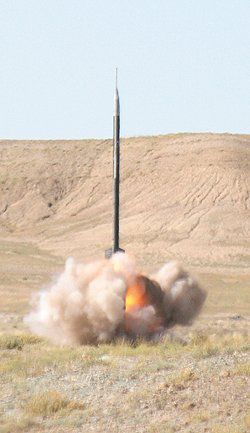The Fifth Annual Intercollegiate Rocket Engineering Competition was held in Green River on June 16-18. Participating in the competition were Brigham Young University, Cal State University Long Beach, University of California at Los Angeles, and Embry-Riddle Aeronautical University. This competition is made possible by the Experimental Sounding Rocket Association.
The guest of honor was Robert L. Ammons. Ammons spent 19 years at The Aerospace Corporation, and 21 years in government/industry. He received his BS degree in Mechanical Engineering from New Mexico State University in 1956 and his MS degree in 1957. Some of the projects he was involved with during his career were helping to establish the Astro Met Division of Thiokol Chemical Corporation in Ogden, and was instrumental in the development of the Tomahawk and Nike-Tomahawk sounding rockets. While employed by the Missile Systems Division of Atlantic Research Corporation in Costa Mesa, Calif., he worked on the Athena, a four stage re-entry test vehicle that was launched from Green River, Utah into White Sands Missile range, New Mexico.
Last year’s competition winner was California State University Long Beach.
The colleges all came to Green River to see if the rockets they worked on throughout the winter months would actually fly. This was a judged competition with several areas of criteria.
This is the fifth year the rocket competition has taken place in Green River. The participants check in at the John Wesley Powell River History museum and the actual rocket launch takes place at the Green River White Sands Missile Base.
The desert near Green River is the perfect environment to explore the world of rockets. The White Sands Missile Base in New Mexico used Green River as a testing ground in the 1960s and 70s with the Athena and other rockets being launched from the Green River Test Site. But rocket launching is not just a part of Green River’s past, it is part of their future, too, as these modern rocket scientists and their students came to Green River to launch their creations.
The judges job is to rate each team on their projects and determine the winner. Before the launch competition began, the teams were required to send the judges an 11 page paper summarizing their rocket design. They must also give a 45 minute oral presentation summarizing their rocket design. This oral presentation took place at the John Wesley Powell River History Museum meeting room.
The Environmental Sounding Rocket Association, in conjunction with Alliance Technical Systems (formerly Thiokol) sponsor the competition for budding engineers to display their talents. Many aerospace engineers come out to the competition to watch and take notes on the quality of engineers being turned out by the universities. The future of the aerospace industry will be in the hands of the graduates of today.
At the launch site, the teams construct their rockets with the aim of launching it and its 10 pound payload 10,000 feet in the air. In addition to the successful launch, the team is required to recover the rocket and it must be in reusable condition. The payload must not be harmed and recoverable also. Maximum points are given to the team whose rocket reaches exactly 10,000 feet in altitude.
A barometric altimeter is installed in the rocket to produce a continuous readout of altitude which allows the team on the ground to know the exact height reached by the rocket. Within one hour of the recovery of the rocket, the team must submit a printout of the altitude to the judges.
The professor said, “This competition is for students to show what they can do. This is the fifth annual competition and Green River has been good to us. We want this competition to grow and have many more teams.”
Up, up and away

"The rocket from Brigham Young University lifts off at the Green River Missile Base."
